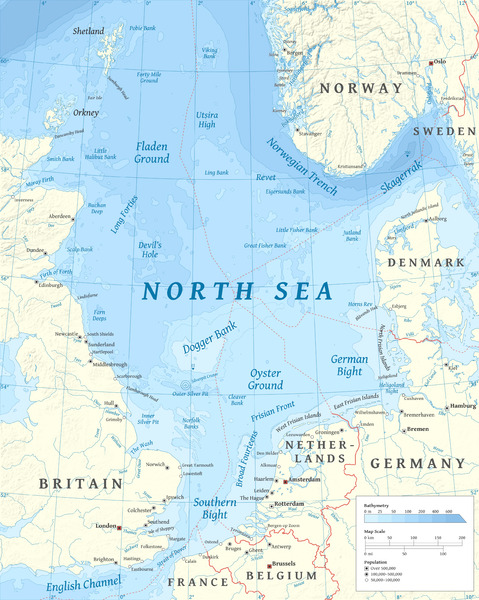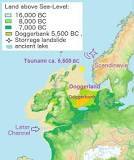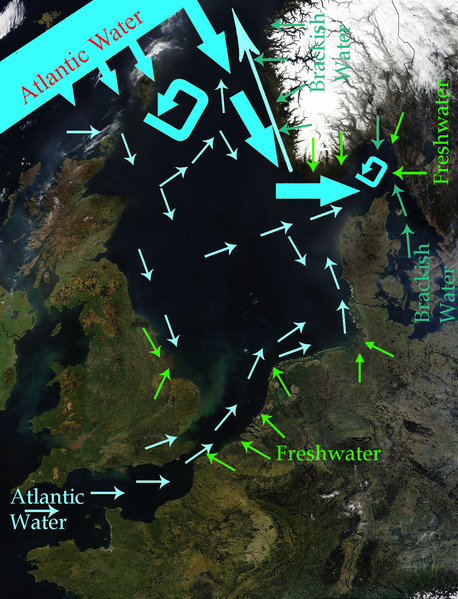#CanyouswiminNorthSea?
Explore tagged Tumblr posts
Text
About North Sea, facts and maps

The North Sea (historically also known as the German Ocean) is a part of the Atlantic Ocean, located between Norway and Denmark in the east, Scotland and England in the west, and Germany, the Netherlands, Belgium and France in the south. The North Sea is one of the world's most important fishing grounds. The sea is also rich in oil and gas. Anthropogenic impacts have been significant for many years. The North Sea is a body of water surrounded by the following countries: Norway – Vestlandet. Denmark – separating it from the Baltic Sea. Germany – the states of Schleswig-Holstein and Lower Saxony, with ports at Bremerhaven and Hamburg. The North Sea lies between Great Britain, Norway, Denmark, Germany, the Netherlands, Belgium and France. An epeiric sea on the European continental shelf, it connects to the Atlantic Ocean through the English Channel in the south and the Norwegian Sea in the north. It is more than 970 kilometres (600 mi) long and 580 kilometres (360 mi) wide, covering 570,000 square kilometres (220,000 sq mi). It hosts key north European shipping lanes and is a major fishery. The coast is a popular destination for recreation and tourism in bordering countries, and a rich source of energy resources, including wind and wave power. The North Sea has featured prominently in geopolitical and military affairs, particularly in Northern Europe, from the Middle Ages to the modern era. It was also important globally through the power northern Europeans projected worldwide during much of the Middle Ages and into the modern era. The North Sea was the centre of the Vikings' rise. The Hanseatic League, the Dutch Republic, and the British each sought to gain command of the North Sea and access to the world's markets and resources. As Germany's only outlet to the ocean, the North Sea was strategically important through both World Wars. The coast has diverse geology and geography. In the north, deep fjords and sheer cliffs mark much of its Norwegian and Scottish coastlines respectively, whereas in the south, the coast consists mainly of sandy beaches, estuaries of long rivers and wide mudflats. Due to the dense population, heavy industrialisation, and intense use of the sea and the area surrounding it, there have been various environmental issues affecting the sea's ecosystems. Adverse environmental issues – commonly including overfishing, industrial and agricultural runoff, dredging, and dumping, among others – have led to several efforts to prevent degradation and to safeguard the long-term economic benefits. The International Hydrographic Organization defines the limits of the North Sea as follows: On the Southwest. A line joining the Walde Lighthouse (France, 1°55'E) and Leathercoat Point (England, 51°10'N). On the Northwest. From Dunnet Head (3°22'W) in Scotland to Tor Ness (58°47'N) in the Island of Hoy, thence through this island to the Kame of Hoy (58°55'N) on to Breck Ness on Mainland (58°58'N) through this island to Costa Head (3°14'W) and Inga Ness (59'17'N) in Westray through Westray, to Bow Head, across to Mull Head (North point of Papa Westray) and on to Seal Skerry (North point of North Ronaldsay) and thence to Horse Island (South point of the Shetland Islands). On the North. From the North point (Fethaland Point) of the Mainland of the Shetland Islands, across to Graveland Ness (60°39'N) in the Island of Yell, through Yell to Gloup Ness (1°04'W) and across to Spoo Ness (60°45'N) in Unst island, through Unst to Herma Ness (60°51'N), on to the SW point of the Rumblings and to Muckle Flugga (60°51′N 0°53′W) all these being included in the North Sea area; thence up the meridian of 0°53' West to the parallel of 61°00' North and eastward along this parallel to the coast of Norway, the whole of Viking Bank is thus included in the North Sea. On the East. The Western limit of the Skagerrak . Why is North Sea so rough? Because the North Sea is shallow, with an average depth of less than 328 feet, its waters can get choppy -- a result of tidal patterns and storms. While all this churning brings up nutrients to the surface that help its marine life thrive, it's not ideal for cruising outside of the summer months. Which countries own the North Sea? While most reserves lie beneath waters belonging to the United Kingdom and Norway, some fields belong to Denmark, the Netherlands, and Germany. Most oil companies have investments in the North Sea. Can you swim in North Sea? For example, the North Sea in the UK, which is on our doorstep, has very low sea temperatures, but that doesn't stop people from swimming in it. In fact, on the northeast coast of England, there are many beaches where you can swim in the icy water year-round!

Who owns oil in the North Sea? The Norwegian and British sectors hold most of the large oil reserves. It is estimated that the Norwegian sector alone contains 54% of the sea's oil reserves and 45% of its gas reserves. What is a North Sea danger? The North Sea is one of the most dangerous seas in the world. It has wild storms and foggy winters. Because the sea is mostly shallow, the currents are strong and often pull in different directions. Even though the North Sea can be dangerous, it is important to trade. Is North Sea a land?

Doggerland is a submerged land mass beneath what is now the North Sea, that once connected Britain to continental Europe. Named after the Dogger Bank, which in turn was named after the 17th-century Dutch fishing boats called doggers.

How warm is the water in the North Sea? Unsurprisingly the sea is colder in the northern extremes of the sea where temperatures reach an average low of around 6 °C (43 °F). The warmest summer temperatures are seen to the south and can regularly reach 18 °C (64 °F) in August. Is the North Sea very cold?

The waters of the North Sea are cold, ranging between 14 and 20 degrees C in the summer months. If you come from a country where the sea water temperature is above 22 degrees C all summer, and up to 26 degrees, it will be hard for you to swim in the chilly water of the North Sea. How deep is the North Sea? 700 m How much oil is left in North Sea? "The waters off the coast of the UK still contain oil and gas reserves equivalent to 15 billion barrels of oil equivalent (boe), enough to fuel the UK for 30 years, but more investment in exploration is needed to slow down the decline in domestic production to safeguard the nation's energy security.

Does the North Sea have fish?

Today mainly mackerel, Atlantic cod, whiting, coalfish, European plaice, and sole are caught. In addition, common shrimp, lobster, and crab, along with a variety of shellfish are harvested. Why is North Sea water brown? When the water looks murky or brown, it means there is a lot of mud, or sediment, in the water. Sediment particles can be so tiny that they take a long time to settle to the bottom, so they travel wherever the water goes. Rivers carry sediment into the bay, and waves and tides help keep the sediment suspended. Why do we sell North Sea oil? Currently 80% of North Sea oil is exported because there is little demand from the country's refineries for UK crude oil. But even gas – where there is domestic demand – is sold overseas. Does China own North Sea oil? Chinese investments in the North Sea China National Offshore Oil Corporation, or CNOOC, has stakes in multiple North Sea oil fields including one of the UK's highest producers Buzzard. CNOOC has further stakes in Golden Eagle, and the combined platform which oversees the Scott, Telford and Rochelle fields. Why is North Sea oil so important? Over its lifetime, the North Sea has contributed approximately NOK 16.5 trillion ($1.82 trillion at the time of writing) in today's NOK to the economy. In 2021 alone, it made up 20% of GDP, 20% of government revenues, 20% of investments, and 50% of total exports. What lives at the bottom of the North Sea?

Worms, crustaceans and shellfish live in holes and tunnels under the surface of the sea floor. If you look closely, you can identify quite a lot of life on the bottom: crabs and sea snails, such as laver spire shells and periwinkles, crawl around. Lots of other animals are attached to stones or ship wrecks. Is the North Sea very polluted? New research led by Cambridge earth scientists has documented heavy metal pollution along the North Sea coast over the last century. The study, published in the Marine Pollution Bulletin, used dog whelks collected from the Belgian and Dutch foreshores as a tool to identify changes in lead pollution over time. What is the North Sea also called?

The North Sea (historically also known as the German Ocean) is a part of the Atlantic Ocean, located between Norway and Denmark in the east, Scotland and England in the west, and Germany, the Netherlands, Belgium and France in the south. Is Atlantis in the North Sea? While Plato's story explicitly locates Atlantis in the Atlantic Ocean near the Pillars of Hercules, location hypotheses include Helike, Thera, Troy, and the North Pole. Is the North Sea salt water? The salinity averages between 34 and 35 grams per litre (129 and 132 g/US gal) of water. The salinity has the highest variability where there is fresh water inflow, such as at the Rhine and Elbe estuaries, the Baltic Sea exit and along the coast of Norway. Is the North Sea nice?

Seemingly endless beaches, chugging ships passing by, warm sand between your toes: The view of the North Sea landscape is impressive. So it's not surprising that many vacationers struggle to decide where to go on the North Sea. All the beaches have a unique charm there, yet some stand out in particular. The North Sea is bounded by the Orkney Islands and east coast of Great Britain to the west and the northern and central European mainland to the east and south, including Norway, Denmark, Germany, the Netherlands, Belgium, and France. In the southwest, beyond the Straits of Dover, the North Sea becomes the English Channel connecting to the Atlantic Ocean. In the east, it connects to the Baltic Sea via the Skagerrak and Kattegat, narrow straits that separate Denmark from Norway and Sweden respectively. In the north it is bordered by the Shetland Islands, and connects with the Norwegian Sea, which is a marginal sea in the Arctic Ocean. The North Sea is more than 970 kilometres (600 mi) long and 580 kilometres (360 mi) wide, with an area of 750,000 square kilometres (290,000 sq mi) and a volume of 54,000 cubic kilometres (13,000 cu mi). Around the edges of the North Sea are sizeable islands and archipelagos, including Shetland, Orkney, and the Frisian Islands. The North Sea receives freshwater from a number of European continental watersheds, as well as the British Isles. A large part of the European drainage basin empties into the North Sea, including water from the Baltic Sea. The largest and most important rivers flowing into the North Sea are the Elbe and the Rhine – Meuse. Around 185 million people live in the catchment area of the rivers discharging into the North Sea encompassing some highly industrialized areas. Major features For the most part, the sea lies on the European continental shelf with a mean depth of 90 metres (300 ft). The only exception is the Norwegian trench, which extends parallel to the Norwegian shoreline from Oslo to an area north of Bergen. It is between 20 and 30 kilometres (12 and 19 mi) wide and has a maximum depth of 725 metres (2,379 ft). The Dogger Bank, a vast moraine, or accumulation of unconsolidated glacial debris, rises to a mere 15 to 30 m (50 to 100 ft) below the surface. This feature has produced the finest fishing location of the North Sea. The Long Forties and the Broad Fourteens are large areas with roughly uniform depth in fathoms (forty fathoms and fourteen fathoms or 73 and 26 m or 240 and 85 ft deep, respectively). These great banks and others make the North Sea particularly hazardous to navigate, which has been alleviated by the implementation of satellite navigation systems. The Devil's Hole lies 320 kilometres (200 mi) east of Dundee, Scotland. The feature is a series of asymmetrical trenches between 20 and 30 kilometres (12 and 19 mi) long, one and two kilometres (0.6 and 1.2 mi) wide and up to 230 metres (750 ft) deep. Other areas which are less deep are Cleaver Bank, Fisher Bank and Noordhinder Bank. Read the full article
#AretherewhalesintheNorthSea?#CanyouswiminNorthSea?#CanyouswimintheNorthSea?#DoesChinaownNorthSeaoil?#DoesitsnowintheNorthSea?#DoestheNorthSeagettsunamis?#DoestheNorthSeahavefish?#HowbigistheNorthSea?#HowdeepistheNorthSea?#HowmuchoilisleftinNorthSea?#Howmuchoilisleftintheworld?#HowwarmisthewaterintheNorthSea?#IsAtlantisintheNorthSea?#IsitNorthSea?#IsNorthSeaaland?#IstheNorthSeacold?#IstheNorthSeanice?#IstheNorthSeasaltwater?#IstheNorthSeaverycold?#IstheNorthSeaverypolluted?#IstheNorthSeawarm?#WhatcountryistheNorthSeain?#WhatisaNorthSeadanger?#WhatishappeningintheNorthSea?#WhatisspecialaboutNorthSea?#WhatisspecialabouttheNorthSea?#WhatistheNorthSeaalsocalled?#WhatistheNorthSeacalled?#WhatistheNorthSeaknownfor?#WhatlivesatthebottomoftheNorthSea?
0 notes